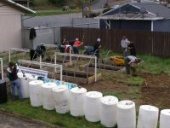
 2
2





Buy Our Book! Food Web: Concept - Raising Food the Right Way. Learn make more food with less inputs
Off Grid Homesteading - latest updates and projects from our off grid homestead




Our inability to change everything should not stop us from changing what we can.




Buy Our Book! Food Web: Concept - Raising Food the Right Way. Learn make more food with less inputs
Off Grid Homesteading - latest updates and projects from our off grid homestead




Cool temperate food forest, vegetables, herbs, chickens and bees all Down Under




Chris McLeod wrote:Hi Abe. Wicking beds are a great idea. Down under we use a lot of shade too over the raised beds. Sometimes, too much light can be as much of a problem as too little, so a bit of shade cloth and/or just grow the vegetables in the complete shade seems to work well here during summer. It didn't rain here for 5 months last summer which was not good, but the food forest barely needed any water during this time as I'm on rainwater and only have limited supplies. The trick with the food forest is to stress the fruit trees a bit over the years so that they forage into the sub surface to get at the ground water. I do not water the fruit trees unless there is going to be a massive heat wave and then they'll only get about half a bucket. No till also helps as the dead herbage underneath the food forest kept the soil shaded, thus reducing evaporation. How do you go with fruit trees in your area over summer? Chris
Buy Our Book! Food Web: Concept - Raising Food the Right Way. Learn make more food with less inputs
Off Grid Homesteading - latest updates and projects from our off grid homestead




Cool temperate food forest, vegetables, herbs, chickens and bees all Down Under




Chris McLeod wrote:Yikes! 8 months without rain is a challenge. Respect. Have you tried apricot trees? They seemed to thrive in the hot dry conditions here.
Also, rather than grafted fruit trees which have root systems that are probably too small for your environment, have you thought about seedling fruit trees which will produce good tap roots which can extend downwards for water during the dry periods? They grow true to type more often than not. People favour grafted trees because the tree will be smaller overall and thus more manageable, but this is not necessarily a useful trait in our environments. Truth is people are a bit scared by a 20m (60ft) lemon tree!
Buy Our Book! Food Web: Concept - Raising Food the Right Way. Learn make more food with less inputs
Off Grid Homesteading - latest updates and projects from our off grid homestead




Robert Ray wrote: I'm considering turning all my raised beds to wicking beds.






|
I have a knack for fixing things like this ... um ... sorry ... here is a concilitory tiny ad:
montana community seeking 20 people who are gardeners or want to be gardeners
https://permies.com/t/359868/montana-community-seeking-people-gardeners
|





